基于信息增强超图神经网络的寄生虫病联合用药预测
IF 6.2
2区 计算机科学
Q1 COMPUTER SCIENCE, THEORY & METHODS
Future Generation Computer Systems-The International Journal of Escience
Pub Date : 2025-05-29
DOI:10.1016/j.future.2025.107913
引用次数: 0
摘要
虽然药物联合疗法是治疗寄生虫病的一种行之有效的策略,但由于所涉及的组合空间巨大,确定新的协同药物组合构成了一项挑战。最近,计算方法已经成为一种高效和经济的方法来优先考虑测试组合。然而,治疗寄生虫病的已知药物组合有限,这对训练计算模型进行准确预测构成了挑战。为了解决上述问题,我们提出了一种基于信息增强超图神经网络的计算方法,名为IHGNNDDS,用于预测针对寄生虫病的潜在协同药物组合。首先,将从PubChem数据库中收集的已知药物组合转换为药物协同超图。然后,设计信息增强超图神经网络(IHGNN),包括拓扑级的预学习增强和语义级的属性增强,以充分挖掘超图中的现有信息。将从超图中学习到的药物和寄生虫病的特征按照三元组结构进行串联,然后输入到预测模块中,用于识别针对寄生虫病的潜在协同药物组合。在对比实验中,IHGNNDDS优于所有基线方法,在预测精度上有显著提高。案例研究结果证明,IHGNNDDS具有识别潜在协同药物组合的能力。本文章由计算机程序翻译,如有差异,请以英文原文为准。
Drug combination prediction for parasitic diseases through information-augmented hypergraph neural network
Although drug combination therapies are a well-established strategy in the treatment of parasitic diseases, identifying novel synergistic drug combinations poses a challenge due to the vast combinatorial space involved. Recently, computational approaches have emerged as an efficient and cost-effective means to prioritize combinations for testing. However, the limited availability of known drug combinations for treating parasitic diseases poses a challenge, hindering the training of computational models for accurate predictions. To address the above issue, we propose an information-augmented hypergraph neural network-based computational method named IHGNNDDS to predict potential synergistic drug combinations targeting parasitic diseases. First, the known drug combinations collected from PubChem database are converted into a drug synergy hypergraph. Then, information-augmented hypergraph neural network (IHGNN), consisting of pre-learning augmentation of topology-level and attribute augmentation of semantic-level, is designed to fully explore the existing information in the hypergraph. The features of the drugs and parasitic diseases learned from the hypergraph are concatenated according to the triplet structures and then input into the prediction module for identifying potential synergistic drug combinations targeting parasitic diseases. In the comparison experiments, IHGNNDDS surpasses all baseline methods, demonstrating notable improvements in predictive accuracy. The results of case study prove that IHGNNDDS has the ability to identify potential synergistic drug combinations.
求助全文
通过发布文献求助,成功后即可免费获取论文全文。
去求助
来源期刊
CiteScore
19.90
自引率
2.70%
发文量
376
审稿时长
10.6 months
期刊介绍:
Computing infrastructures and systems are constantly evolving, resulting in increasingly complex and collaborative scientific applications. To cope with these advancements, there is a growing need for collaborative tools that can effectively map, control, and execute these applications.
Furthermore, with the explosion of Big Data, there is a requirement for innovative methods and infrastructures to collect, analyze, and derive meaningful insights from the vast amount of data generated. This necessitates the integration of computational and storage capabilities, databases, sensors, and human collaboration.
Future Generation Computer Systems aims to pioneer advancements in distributed systems, collaborative environments, high-performance computing, and Big Data analytics. It strives to stay at the forefront of developments in grids, clouds, and the Internet of Things (IoT) to effectively address the challenges posed by these wide-area, fully distributed sensing and computing systems.

 求助内容:
求助内容: 应助结果提醒方式:
应助结果提醒方式:


